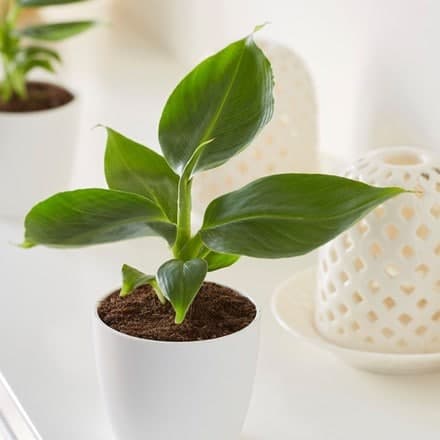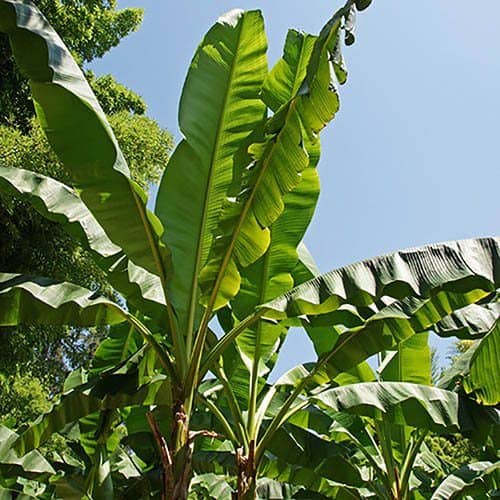Musa Cavendish ‘Super Dwarf Banana’
Musa Cavendish has a rather interesting background in the UK. It was first brought to the UK in 1834 by a chaplain as a gift to the 6th Duke of Devonshire, William Cavendish. He cultivated them and named them after himself.
It is unclear if the chaplain got the banana plant that was named after the duke from Southeast Asia or Australia where they originate from. Its other common names are Dwarf Cavendish, Small dwarf banana, Musa dwarf cavendish, or Dwarf cavendish banana.
The names of this banana plant give you a clear insight into the size of the plant. It is a short plant growing to only 5 to 10 feet. The lush, green leaves are about 4 feet long and are extremely fragile but new leaves will emerge every week as long as your plant is getting all the care it needs.
Also, they produce unusual but beautiful flowers that appear before the rare banana fruit emerges. This is quite uncommon for indoor plants but if your dwarf cavendish is grown outdoors it will produce these pretty flowers.
Growing and Caring For Musa Cavendish
They are delicate plants but quite easy to grow once they have the right growing conditions. They grow quickly in the right conditions and will reward you for caring for them with new leaves every other day.
Musa Cavendish propagation
The traditional method for propagating banana plants is through vegetative propagation of the corms and suckers or the more innovative method of tissue cultivation. The tissue cultivation propagation method for banana plants is considered a better option because the corm and suckers used in the traditional method accommodate nematodes, fungi, insects, and viruses that spread to the new plants.
Other great banana trees or banana plants to grow and buy in the UK are of course the Musa Basjoo, Ensete ventricosum ‘Maurelii’ – Red Abyssinian Ethiopian banana, Musa lasiocarpa, Musa Sikkimensis and Musa Acuminata Dwarf Cavendish.
- How to overwinter banana plants through the winter months
- GROW GUIDE: How to grow banana plants
- What Should I Plant with Musa Basjoo?
- Can you grow a banana plant indoors?
- Can you grow banana fruit in a UK garden?
Where to buy Musa Cavendish or find for sale in the UK:
Ideal growing conditions for Musa Cavendish
- Soil: Cavendish banana appreciates well-draining and slightly acidic soil that is kept constantly moist but never wet. A layer of mulch over the root is a great idea to preserve moisture.
- Light: This plant likes a lot of light but will accept different light conditions. What is needed is partial shade, full sun, or dappled sunlight. Young leaves will scorch under the intensity of the afternoon sun, especially without a good watering routine.
- Water: Like most banana plants, this banana plant needs to be constantly watered. It easily gets dehydrated because of its wide leaves that allow transpiration. During winter and other cooler seasons, watering should be reduced for indoor plants to avoid root rot from overwatering.
- Fertiliser: Feed with a general liquid fertiliser once every two to three weeks to aid its fast-growing nature.
- Pests and diseases: They suffer no serious disease or pest infestation. Common pests are aphids and red spider mites and they can suffer root rot if overwatered.
- Temperature and Humidity: Low humidity is a common cause of leaf damage but misting the leaves can help. For indoor plants, there are no temperatures within your home that will be too high or too low to hurt your plant but outdoor plants can be easily damaged by temperature levels below 10oC.
Other types of banana trees / banana plants you can buy and grow in the UK
Musa Cavendish 'Super Dwarf Banana' – A Compact, Fruit-Bearing Banana Plant for UK Gardens
The Musa Cavendish 'Super Dwarf Banana' is a compact cultivar of the popular Cavendish banana plant, making it a suitable choice for UK gardeners looking for a fruit-bearing, space-saving addition to their gardens. This article will provide an overview of the characteristics, cultivation, and care of the Musa Cavendish 'Super Dwarf Banana,' tailored for UK gardens.
Origins and Characteristics
The 'Super Dwarf Banana' is a cultivar of the Musa acuminata, part of the Cavendish group. Known for its small size, it usually grows to a height of 1.5-2 metres, which is significantly shorter than other Cavendish varieties. Despite its compact size, the 'Super Dwarf Banana' still produces sweet, edible fruits, making it a popular choice for those with limited space in their gardens.
Cultivation and Care
For successful growth of the Musa Cavendish 'Super Dwarf Banana' in UK gardens, adhere to these care guidelines:
- Soil: Plant in well-draining soil with a slightly acidic pH level of 6.0 to 6.5. Enriching the soil with organic matter, such as compost, can enhance fertility and drainage.
- Light: This plant thrives in full sun, requiring at least 6 hours of direct sunlight daily. Although it can tolerate some shade, full sun is ideal for optimal growth and fruit production.
- Water: Ensure consistent moisture by watering regularly to keep the soil moist, but not waterlogged. Be cautious not to overwater, as this can lead to root rot.
- Fertilisation: During the growing season (spring through summer), apply a balanced, slow-release fertiliser to support growth and fruit production.
- Winter Care: The Musa Cavendish 'Super Dwarf Banana' is not frost-hardy. In colder climates, grow the plant in a container and move it indoors or to a heated greenhouse during the winter months.
Landscape Use
The compact size of the Musa Cavendish 'Super Dwarf Banana' makes it a versatile addition to various garden settings. It is ideal for small gardens, mixed borders, or container gardens, where its lush, tropical foliage and fruit production can be showcased. The plant serves as a beautiful focal point, bringing an exotic touch to the landscape.
Conclusion
The Musa Cavendish 'Super Dwarf Banana' is a compact, fruit-bearing banana plant well-suited for UK gardens with limited space. By following the cultivation tips provided in this article, UK gardeners can successfully grow and enjoy the beauty and fruit of the 'Super Dwarf Banana' in their gardens.









